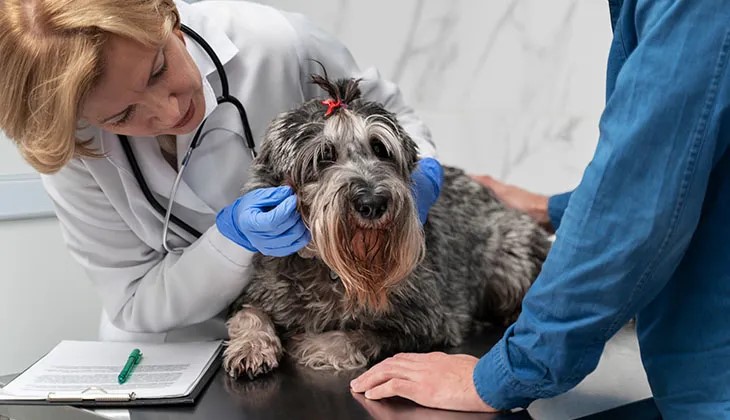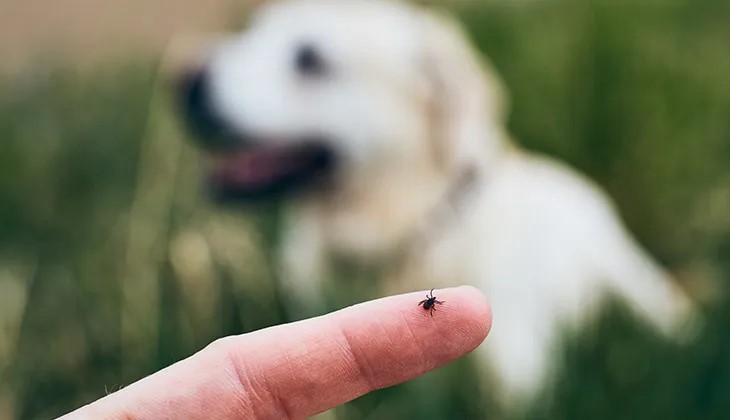Canine Babesiosis – On the Rise

What is babesiosis?
Fleas and ticks can transmit serious diseases to your dog, which may be fatal. Babesiosis is caused by a parasite – babesia – which can be transmitted by certain ticks. Many different diseases can be carried by various species of ticks, which vary according to the country you live in. It is one of the most widespread and common of all vector-borne diseases in dogs and occurs on every continent, apart from Antarctica.
It attacks the dog’s blood cells, causing several serious symptoms.
How do dogs get infected?
The babesia parasite is transmitted by ticks which have become infected by feeding on infected dogs. Female ticks, which produce thousands of eggs, can pass it on to their own offspring too, increasing the likelihood of widespread transmission to many dogs. It may also be passed on by blood through fighting or from a blood transfusion.
Are there always symptoms of infection?
Not necessarily. Many dogs can be infected and not show any symptoms. The vet may do blood tests which show positive antibodies to babesiosis while the dog, who is a carrier of the disease, may have no symptoms. This indicates that the dog has had a bite from an infected tick. Their infected ticks can unfortunately spread the disease to ticks in their environment, even though the dog appears to be healthy. They can also get the disease again, especially when they are stressed or immune-suppressed.

What are the symptoms of babesiosis?
Infected dogs have some degree of anaemia and, in some cases, certain organs may be affected. They may have mild symptoms or may suffer from widespread organ failure and could die.
Factors which may affect the severity of babesiosis include:
- Co-morbidities, such as immune-suppressant conditions;
- Age (young dogs are more at risk) and level of immunity;
- Other tick-borne diseases.
Symptoms of babesiosis disease include:
- Loss of appetite
- General weakness progressing to collapse
- Lethargy
- Pale mucous membranes (in the eyes and mouth)
Are some dogs more at risk of infection?
Bear in mind that any dog is at risk of infection, but there are certain factors which may put them more at risk:
- Dogs who spend a lot of time outdoors in natural environments where more ticks may be found;
- When dogs live with many other dogs, such as in kennels and shelters;
- Those dogs who have not been protected by tick treatments: e.g. Bravecto®.
- Male dogs who have not been sterilized (possibly because they tend to roam more) are more at risk than unsterilized males and females.
- Certain breeds appear to be more likely to be bitten by infected ticks and are more susceptible to babesiosis disease: Pit Bulls, Staffordshire Terriers and their cross breeds.
Are other pets or humans at risk of catching babesiosis?
Under normal conditions, babesiosis is not contagious like influenza. However, a bite from an infected dog may transmit this disease to other dogs. It may also be transmitted by infected ticks from one dog to another, so it is very important to administer tick treatments, like Bravecto®, which only requires 4 doses per year.
At the moment the species of babesia that infects dogs is not the same as the one which infects humans. Dog owners should, however, know about the health risks of babesiosis and of tick bites in general.
Can dog owners do anything to prevent babesiosis infections in their dogs?

Administering an effective, consistent tick protection treatment (e.g. Bravecto®) is the best prevention against babesiosis and other diseases carried by ticks. This protection is essential year-round as ticks are present all year. Your vet will advise you about this.
Bear in mind that there is currently no vaccine available to protect dogs against babesiosis infection.
What else can you do?
- Check your pooch frequently for ticks, especially after being in potentially heavily-infested places such as kennels, parks, areas with a lot of vegetation and wild-life.
- Remove any ticks that you find.
- If you send your dog to shared facilities (boarding kennels, day-care, dog parks), ensure that your dog has had tick protection treatment.
- Early diagnosis and treatment of babesiosis is important to reduce the risks from infection by this parasite. Take your dog to the vet as soon as you suspect that there may be a problem.
Remember:
Bravecto® tick and flea treatments can protect your dog year-round, with just 4 doses. They are quick-acting and long-lasting.
How do vets treat dogs with babesiosis?
- Vets administer specific anti-babesial medications and supportive treatment to target anaemia, dehydration and electrolyte imbalances, if necessary.
- They may administer fluid therapy, oxygen therapy and blood transfusions.
- Tick infestations will be treated.
At home, it is also very important to nurse your dog back to good health by keeping him/her warm and by providing a balanced, nutritious diet.
ZA-NON-240200019

Subscribe to our Newsletter
Get to know your furry friend better! Sign up for all things dog- or cat-related.
The Hairy Facts about the dreaded hairball
12 April 2021
Help! My dog’s barking mad! Volume 2
12 April 2021
Your Itchy, Scratchy Cat – All About Cat Skin Problems
12 April 2021
The Dog’s Diet: A Bone of contention?
01 April 2021
Mango Fly Worms: How to Spot and Eliminate them
Posted on November 28,2019
Managing Mange And Mites In Your Dog
Posted on June 11,2018
Why Do Cats Purr and How? Learn What Your Cat Is Saying
Posted on October 14,2020
How to Get Rid of Ear Mites in Dogs
Posted on November 06,2019









